Attached files
| file | filename |
|---|---|
| 8-K - FORM 8-K - Celanese Corp | d79349e8vk.htm |
| EX-99.1 - EX-99.1 - Celanese Corp | d79349exv99w1.htm |
Exhibit
99.2
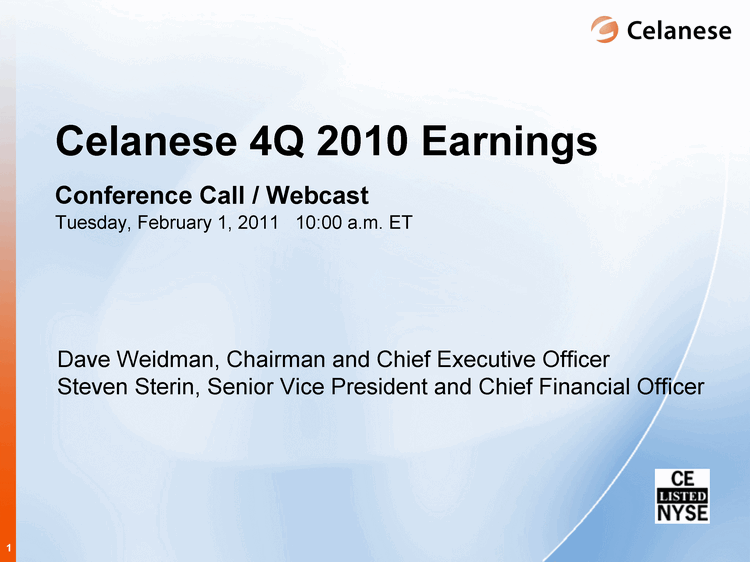
| Dave Weidman, Chairman and Chief Executive Officer Steven Sterin, Senior Vice President and Chief Financial Officer Celanese 4Q 2010 Earnings Conference Call / Webcast Tuesday, February 1, 2011 10:00 a.m. ET |

| Forward looking statements Reconciliation and use of non-GAAP measures to U.S. GAAP This presentation may contain "forward-looking statements," which include information concerning the company's plans, objectives, goals, strategies, future revenues or performance, capital expenditures, financing needs and other information that is not historical information. When used in this release, the words "outlook," "forecast," "estimates," "expects," "anticipates," "projects," "plans," "intends," "believes," and variations of such words or similar expressions are intended to identify forward-looking statements. All forward-looking statements are based upon current expectations and beliefs and various assumptions. There can be no assurance that the company will realize these expectations or that these beliefs will prove correct. There are a number of risks and uncertainties that could cause actual results to differ materially from the results expressed or implied in the forward-looking statements contained in this release. These risks and uncertainties include, among other things: changes in general economic, business, political and regulatory conditions in the countries or regions in which we operate; the length and depth of business cycles, particularly in the automotive, electrical, electronics and construction industries; changes in the price and availability of raw materials; the ability to pass increases in raw material prices on to customers or otherwise improve margins through price increases; the ability to maintain plant utilization rates and to implement planned capacity additions and expansions; the ability to improve productivity by implementing technological improvements to existing plants; increased price competition and the introduction of competing products by other companies; market acceptance of our technology; the ability to obtain governmental approvals and to construct facilities on terms and schedule acceptable to the company; changes in the degree of intellectual property and other legal protection afforded to our products; compliance and other costs and potential disruption of production due to accidents or other unforeseen events or delays in construction or operation of facilities; potential liability for remedial actions and increased costs under existing or future environmental regulations, including those relating to climate change; potential liability resulting from pending or future litigation, or from changes in the laws, regulations or policies of governments or other governmental activities in the countries in which we operate; changes in currency exchange rates and interest rates; and various other factors discussed from time to time in the company's filings with the Securities and Exchange Commission. Any forward-looking statement speaks only as of the date on which it is made, and the company undertakes no obligation to update any forward-looking statements to reflect events or circumstances after the date on which it is made or to reflect the occurrence of anticipated or unanticipated events or circumstances. Reconciliation of Non-U.S. GAAP Measures to U.S. GAAP This presentation reflects the following performance measures: operating EBITDA, business operating EBITDA, proportional affiliate EBITDA and affiliate EBITDA, adjusted earnings per share, net debt and adjusted free cash flow, as non-U.S. GAAP measures. These measurements are not recognized in accordance with U.S. GAAP and should not be viewed as an alternative to U.S. GAAP measures of performance. The most directly comparable financial measure presented in accordance with U.S. GAAP in our consolidated financial statements for operating EBITDA and business EBITDA is operating profit; for proportional affiliate EBITDA is equity in net earnings of affiliates; for affiliate EBITDA is operating profit; for adjusted earnings per share is earnings per common share-diluted; for net debt is total debt; and for adjusted free cash flow is cash flow from operations. Use of Non-U.S. GAAP Financial Information Operating EBITDA, a measure used by management to measure performance, is defined by the company as net earnings plus loss (earnings) from discontinued operations, interest expense, taxes and depreciation and amortization, and further adjusted for Other Charges and Adjustments as described in Table 7. We may provide guidance on operating EBITDA and are unable to reconcile forecasted operating EBITDA to a U.S. GAAP financial measure because a forecast of Other Charges and Adjustments is not practical. Business operating EBITDA, a measure used by management to measure performance of its internal operations, is defined by the company as net earnings plus loss (earnings) from discontinued operations, interest expense, taxes and depreciation and amortization, and further adjusted for Other Charges and Adjustments as described in Table 7, less equity in net earnings of affiliates, dividend income from cost investments and other (income) expense. This reflects the operating results of the company's operations without regard to its equity and cost investments. The company believes that investors should consider business operating EBITDA when evaluating the company's internal operations. Proportional affiliate EBITDA, a measure used by management to measure performance of its equity investments, is defined by the company as the proportional operating profit plus the proportional depreciation and amortization of its equity investments. Affiliate EBITDA is defined by the company as operating profit plus the depreciation and amortization of its equity affiliates. The company has determined that it does not have sufficient ownership for operating control of these investments to consider their results on a consolidated basis. Adjusted earnings per share is a measure used by management to measure performance. It is defined by the company as net earnings (loss) available to common shareholders plus preferred dividends, adjusted for other charges and adjustments, and divided by the number of basic common shares, diluted preferred shares, and options valued using the treasury method. We may provide guidance on an adjusted earnings per share basis and are unable to reconcile forecasted adjusted earnings per share to a U.S. GAAP financial measure without unreasonable effort because a forecast of Other Items is not practical. We believe that the presentation of this non-U.S. GAAP measure provides useful information to management and investors regarding various financial and business trends relating to our financial condition and results of operations, and that when U.S. GAAP information is viewed in conjunction with non-U.S. GAAP information, investors are provided with a more meaningful understanding of our ongoing operating performance. Note: The tax rate used for adjusted earnings per share approximates the midpoint in a range of forecasted tax rates for the year, excluding changes in uncertain tax positions, discrete items and other material items adjusted out of our U.S. GAAP earnings for adjusted earnings per share purposes, and changes in management's assessments regarding the ability to realize deferred tax assets. We analyze this rate quarterly and adjust if there is a material change in the range of forecasted tax rates; an updated forecast would not necessarily result in a change to our tax rate used for adjusted earnings per share. The adjusted tax rate is an estimate and may differ significantly from the tax rate used for U.S. GAAP reporting in any given reporting period. It is not practical to reconcile our prospective adjusted tax rate to the actual U.S. GAAP tax rate in any future period. Net debt is defined by the company as total debt less cash and cash equivalents. We believe that the presentation of this non-U.S. GAAP measure provides useful information to management and investors regarding changes to the company's capital structure. Our management and credit analysts use net debt to evaluate the company's capital structure and assess credit quality. Proportional net debt is defined as our proportionate share of our affiliates' net debt. Adjusted free cash flow is defined by the company as cash flow from operations less capital expenditures, other productive asset purchases, operating cash from discontinued operations and certain other charges and adjustments. We believe that the presentation of this non-U.S. GAAP measure provides useful information to management and investors regarding changes to the company's cash flow. Our management and credit analysts use adjusted free cash flow to evaluate the company's liquidity and assess credit quality. Results Unaudited The results presented in this presentation, together with the adjustments made to present the results on a comparable basis, have not been audited and are based on internal financial data furnished to management. Quarterly results should not be taken as an indication of the results of operations to be reported for any subsequent period or for the full fiscal year. |
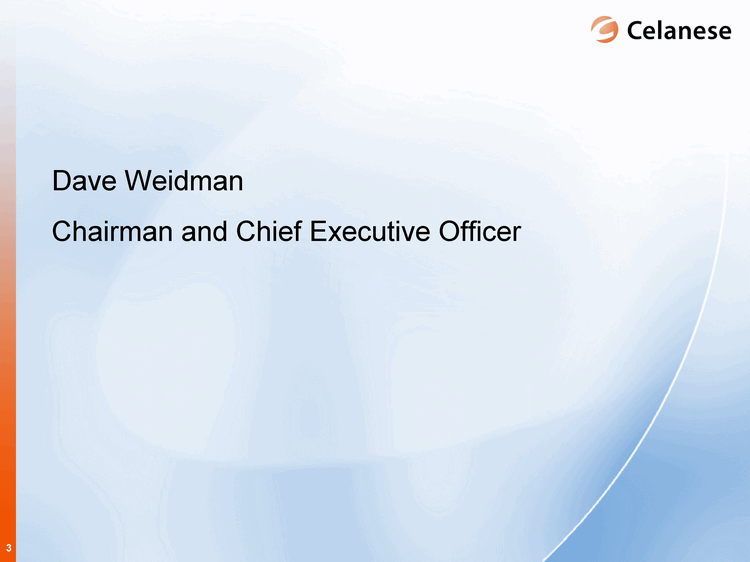
| Dave Weidman Chairman and Chief Executive Officer |
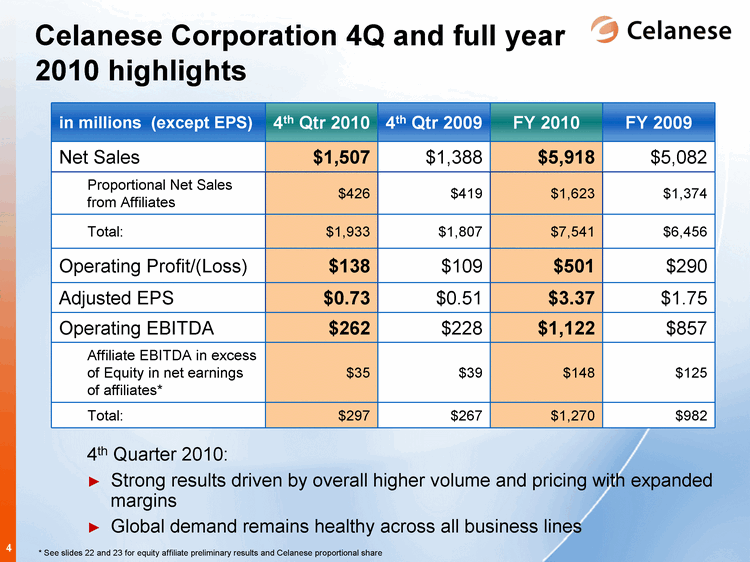
| Celanese Corporation 4Q and full year 2010 highlights in millions (except EPS) 4th Qtr 2010 4th Qtr 2009 FY 2010 FY 2009 Net Sales $1,507 $1,388 $5,918 $5,082 Proportional Net Sales from Affiliates $426 $419 $1,623 $1,374 Total: $1,933 $1,807 $7,541 $6,456 Operating Profit/(Loss) $138 $109 $501 $290 Adjusted EPS $0.73 $0.51 $3.37 $1.75 Operating EBITDA $262 $228 $1,122 $857 Affiliate EBITDA in excess of Equity in net earnings of affiliates* $35 $39 $148 $125 Total: $297 $267 $1,270 $982 4th Quarter 2010: Strong results driven by overall higher volume and pricing with expanded margins Global demand remains healthy across all business lines * See slides 22 and 23 for equity affiliate preliminary results and Celanese proportional share |
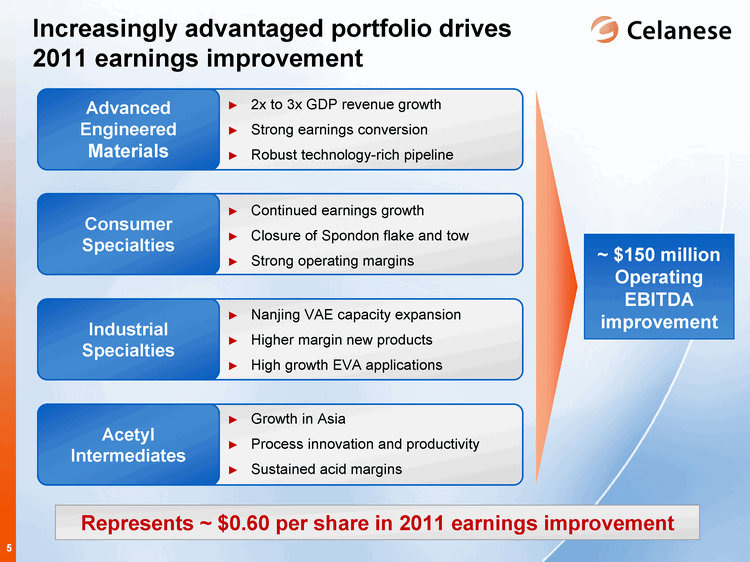
| Represents ~ $0.60 per share in 2011 earnings improvement 2x to 3x GDP revenue growth Strong earnings conversion Robust technology-rich pipeline Continued earnings growth Closure of Spondon flake and tow Strong operating margins Growth in Asia Process innovation and productivity Sustained acid margins ~ $150 million Operating EBITDA improvement Nanjing VAE capacity expansion Higher margin new products High growth EVA applications Increasingly advantaged portfolio drives 2011 earnings improvement Advanced Engineered Materials Consumer Specialties Industrial Specialties Acetyl Intermediates |
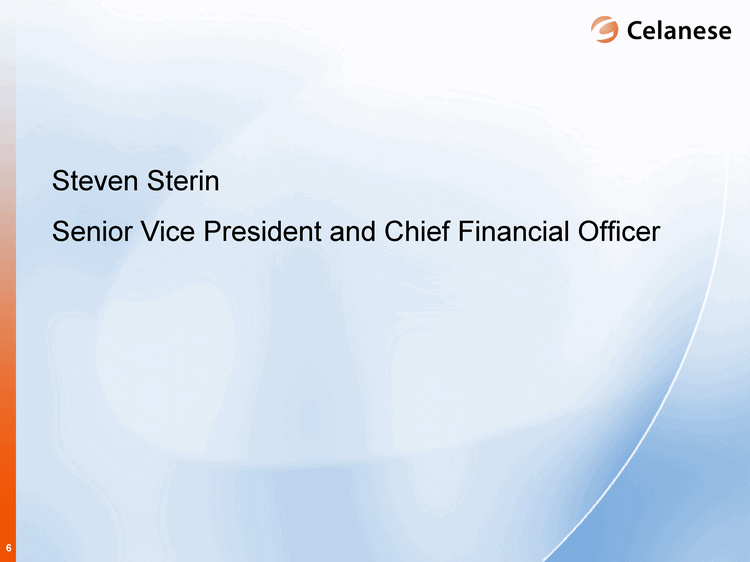
| Steven Sterin Senior Vice President and Chief Financial Officer |
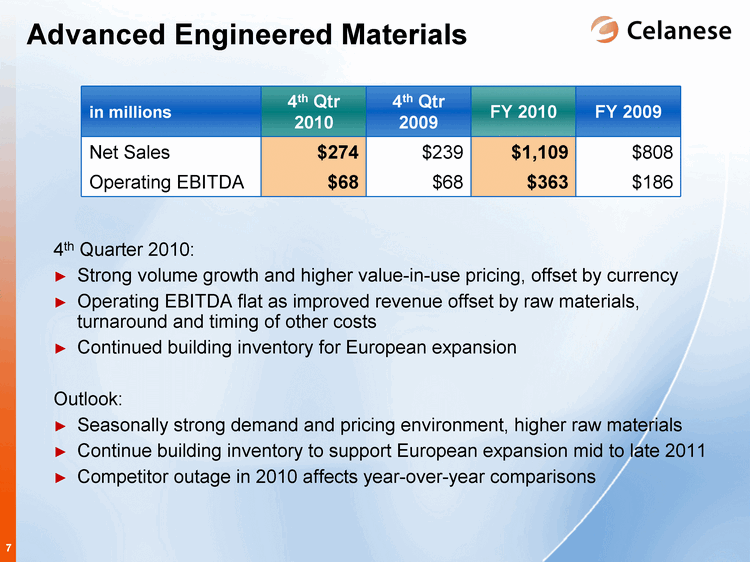
| 4th Quarter 2010: Strong volume growth and higher value-in-use pricing, offset by currency Operating EBITDA flat as improved revenue offset by raw materials, turnaround and timing of other costs Continued building inventory for European expansion Outlook: Seasonally strong demand and pricing environment, higher raw materials Continue building inventory to support European expansion mid to late 2011 Competitor outage in 2010 affects year-over-year comparisons Advanced Engineered Materials in millions 4th Qtr 2010 4th Qtr 2009 FY 2010 FY 2009 Net Sales $274 $239 $1,109 $808 Operating EBITDA $68 $68 $363 $186 |
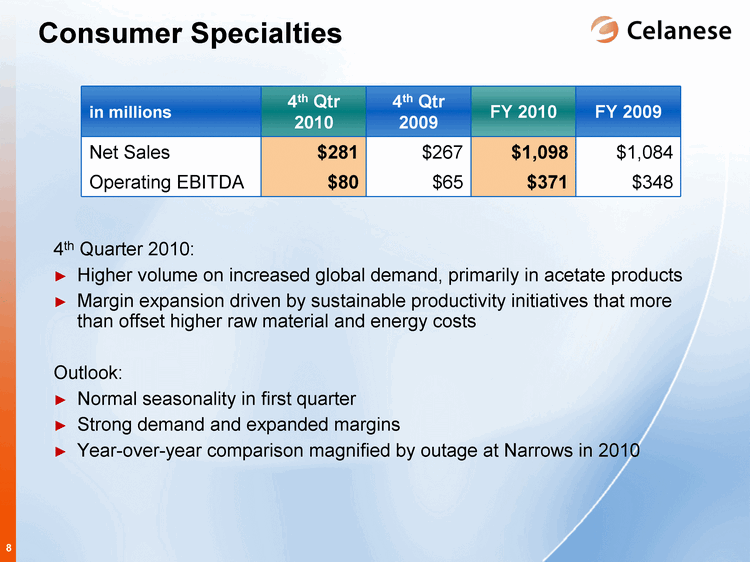
| 4th Quarter 2010: Higher volume on increased global demand, primarily in acetate products Margin expansion driven by sustainable productivity initiatives that more than offset higher raw material and energy costs Outlook: Normal seasonality in first quarter Strong demand and expanded margins Year-over-year comparison magnified by outage at Narrows in 2010 Consumer Specialties in millions 4th Qtr 2010 4th Qtr 2009 FY 2010 FY 2009 Net Sales $281 $267 $1,098 $1,084 Operating EBITDA $80 $65 $371 $348 |

| 4th Quarter 2010: Higher pricing and volume driven by strong demand and innovation, particularly in photovoltaic applications Emulsions business in Asia at full utilization ahead of VAE capacity expansion in Nanjing, China mid-2011 Outlook: Stronger seasonal demand driving volume growth Margin expansion due to robust pricing environment and higher volumes Industrial Specialties in millions 4th Qtr 2010 4th Qtr 2009 FY 2010 FY 2009 Net Sales $249 $229 $1,036 $974 Operating EBITDA $27 $19 $111 $109 |
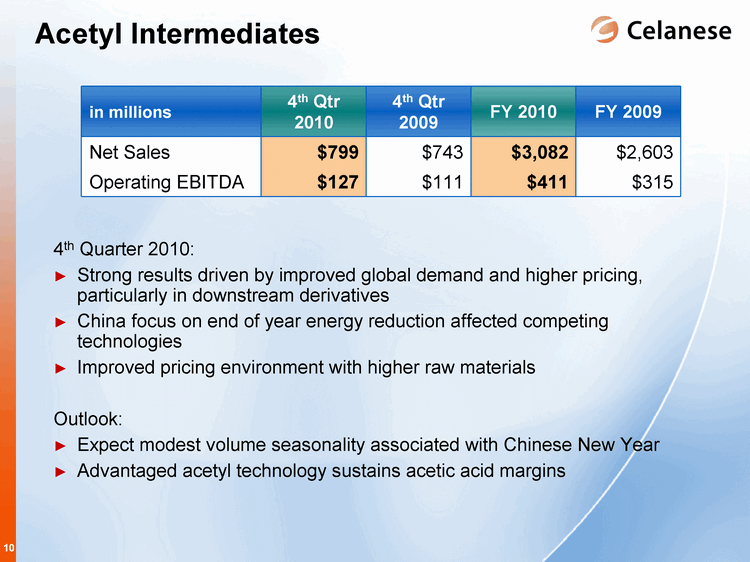
| Acetyl Intermediates 4th Quarter 2010: Strong results driven by improved global demand and higher pricing, particularly in downstream derivatives China focus on end of year energy reduction affected competing technologies Improved pricing environment with higher raw materials Outlook: Expect modest volume seasonality associated with Chinese New Year Advantaged acetyl technology sustains acetic acid margins in millions 4th Qtr 2010 4th Qtr 2009 FY 2010 FY 2009 Net Sales $799 $743 $3,082 $2,603 Operating EBITDA $127 $111 $411 $315 |
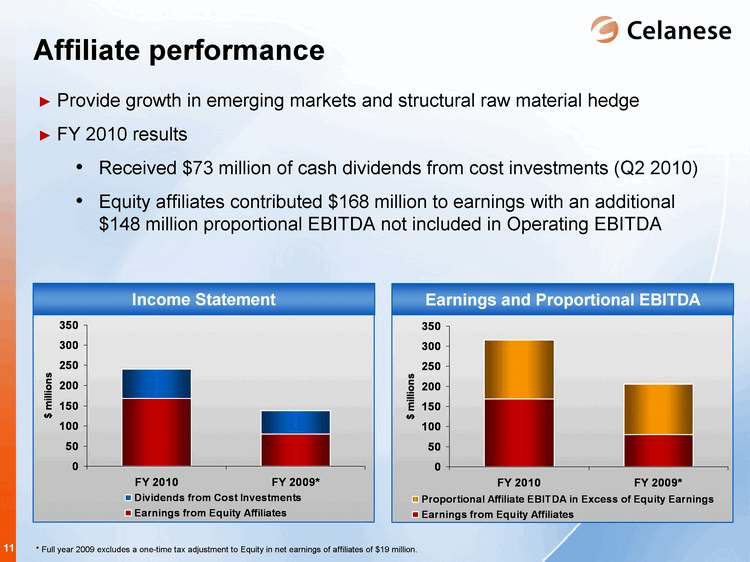
| Provide growth in emerging markets and structural raw material hedge FY 2010 results Received $73 million of cash dividends from cost investments (Q2 2010) Equity affiliates contributed $168 million to earnings with an additional $148 million proportional EBITDA not included in Operating EBITDA Affiliate performance FY 2010 FY 2009* Earnings from Equity Affiliates 168 80 Dividends from Cost Investments 73 57 Income Statement * Full year 2009 excludes a one-time tax adjustment to Equity in net earnings of affiliates of $19 million. FY 2010 FY 2009* Earnings from Equity Affiliates 168 80 Proportional Affiliate EBITDA in Excess of Equity Earnings 148 125 Earnings and Proportional EBITDA |
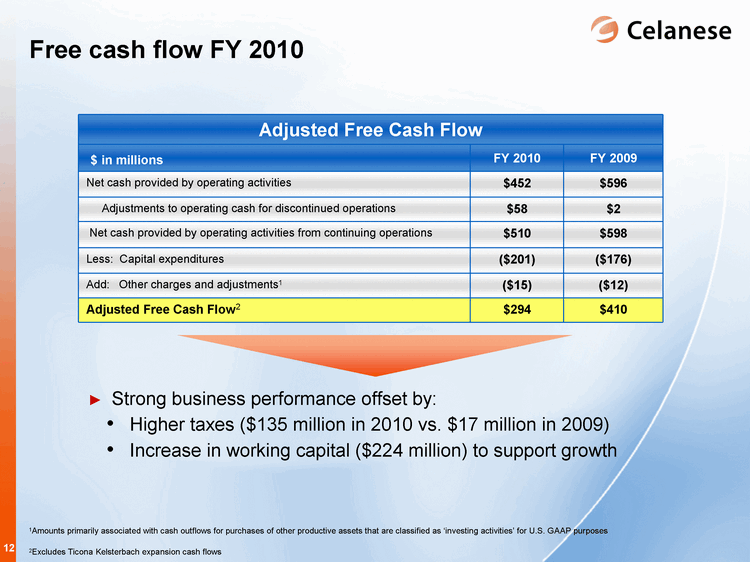
| Free cash flow FY 2010 Adjusted Free Cash Flow Adjusted Free Cash Flow Adjusted Free Cash Flow $ in millions FY 2010 FY 2009 Net cash provided by operating activities $452 $596 Adjustments to operating cash for discontinued operations $58 $2 Net cash provided by operating activities from continuing operations $510 $598 Less: Capital expenditures ($201) ($176) Add: Other charges and adjustments1 ($15) ($12) Adjusted Free Cash Flow2 $294 $410 1Amounts primarily associated with cash outflows for purchases of other productive assets that are classified as 'investing activities' for U.S. GAAP purposes 2Excludes Ticona Kelsterbach expansion cash flows Strong business performance offset by: Higher taxes ($135 million in 2010 vs. $17 million in 2009) Increase in working capital ($224 million) to support growth |

| 2011E Adjusted Free Cash Outflows (off EBITDA Base) 2011E Adjusted Free Cash Outflows (off EBITDA Base) Cash Taxes $75 - $100 Capital Expenditures $300 - $350 Reserve/Other $100 - $120 Net Interest $220 - $230 Pension $120 - $140 Working Capital $30 - $50 Adjusted Cash Outflows* $845 - $990 Dividend, debt service and share repurchases of ~$90-110 million Expect approximately $100 million net cash outflow for Kelsterbach expansion in 2011, including capital expenditures and project expense Strong cash generation continues throughout economic cycle Available Cash Available Cash Cash (as of 12/31/2010) $740 Operating Cash ~($100 - $200) Cash Available for Strategic Purposes ~$600 $ in millions $ in millions * Excludes Ticona Kelsterbach expansion cash flows |
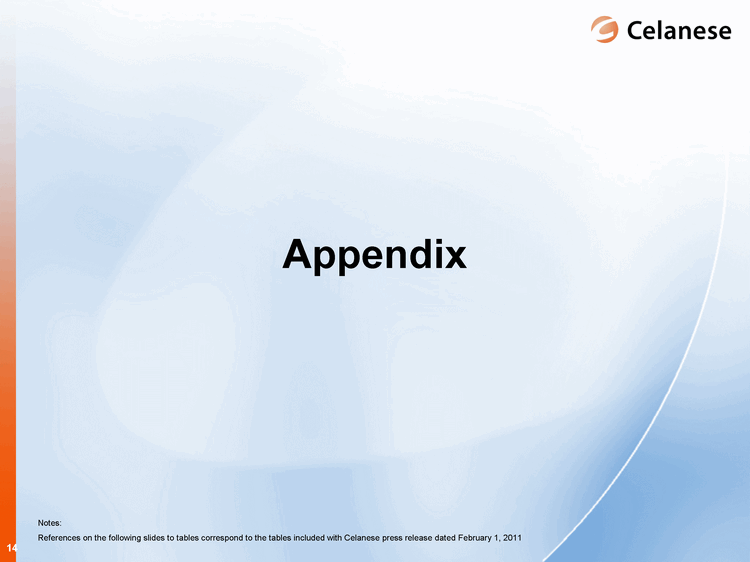
| Appendix Notes: References on the following slides to tables correspond to the tables included with Celanese press release dated February 1, 2011 |
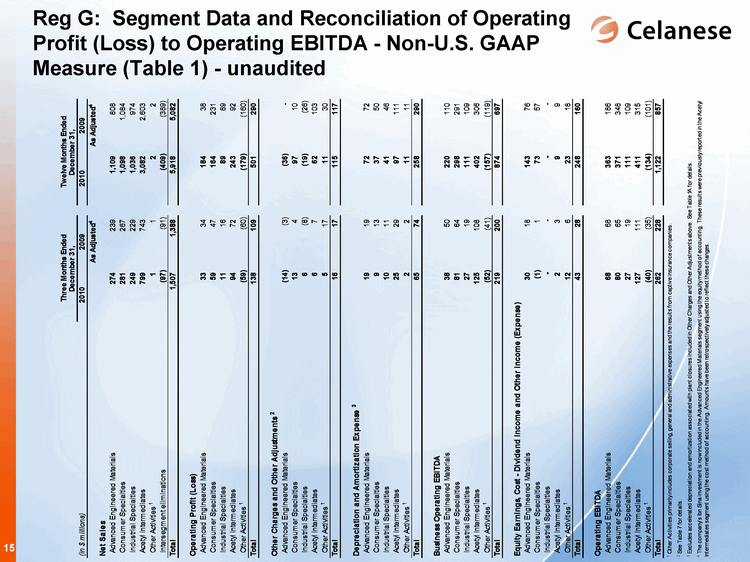
| Reg G: Segment Data and Reconciliation of Operating Profit (Loss) to Operating EBITDA - Non-U.S. GAAP Measure (Table 1) - unaudited |
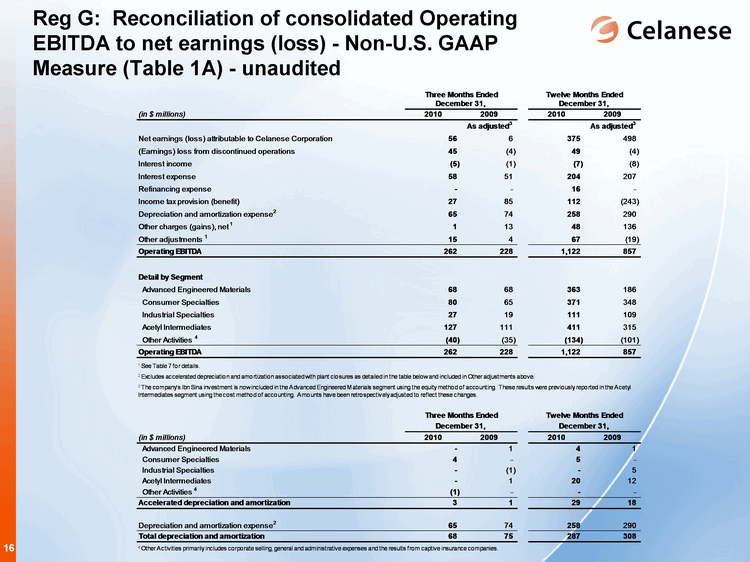
| Reg G: Reconciliation of consolidated Operating EBITDA to net earnings (loss) - Non-U.S. GAAP Measure (Table 1A) - unaudited |
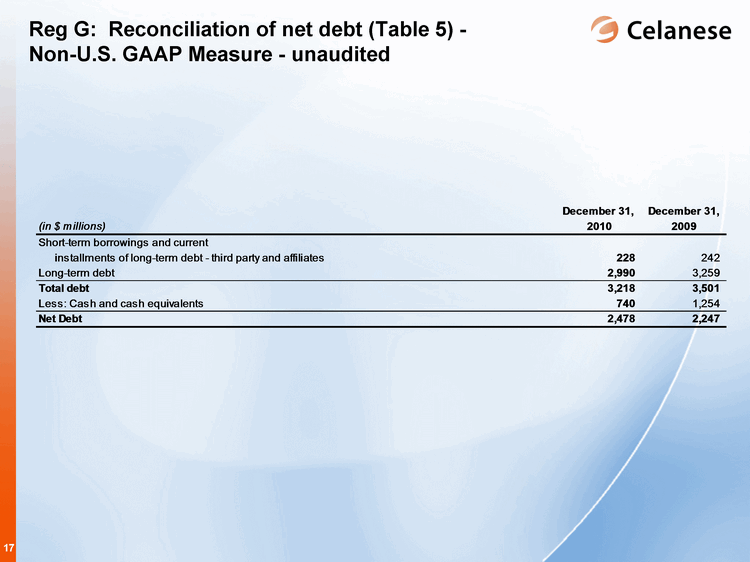
| Reg G: Reconciliation of net debt (Table 5) - Non-U.S. GAAP Measure - unaudited |

| Reg G: Reconciliation of adjusted EPS (Table 6) - Non-U.S. GAAP Measure - unaudited |
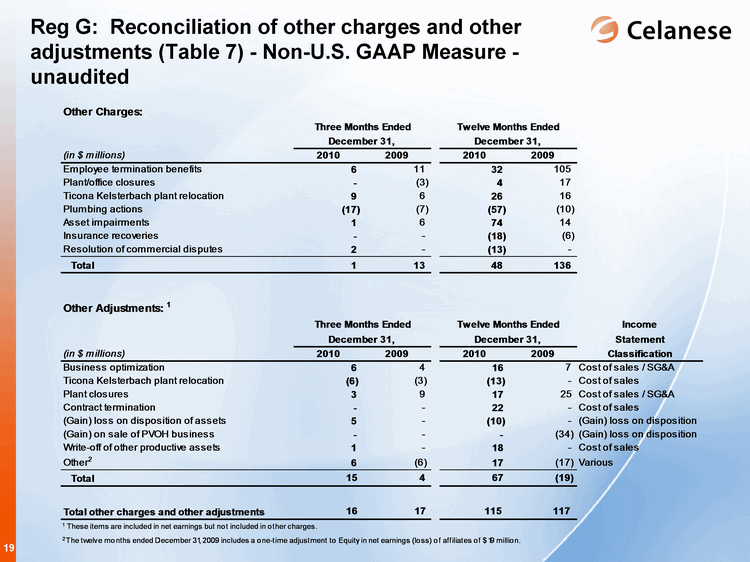
| Reg G: Reconciliation of other charges and other adjustments (Table 7) - Non-U.S. GAAP Measure - unaudited |
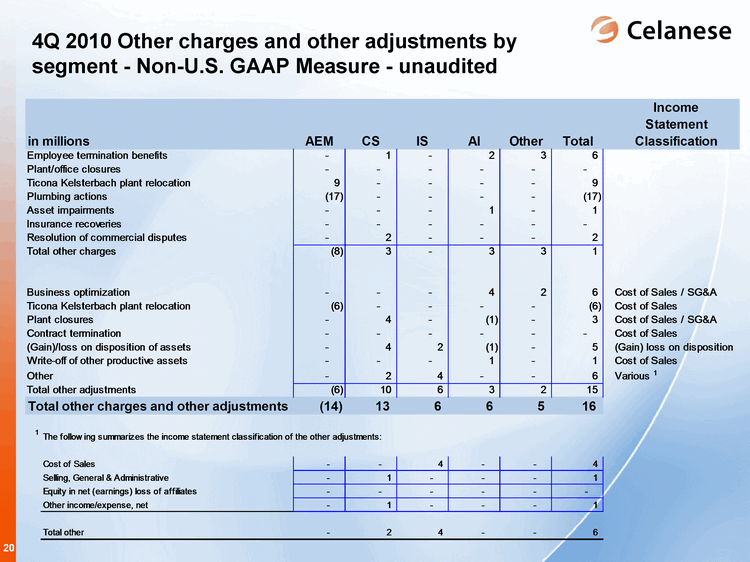
| 4Q 2010 Other charges and other adjustments by segment - Non-U.S. GAAP Measure - unaudited |
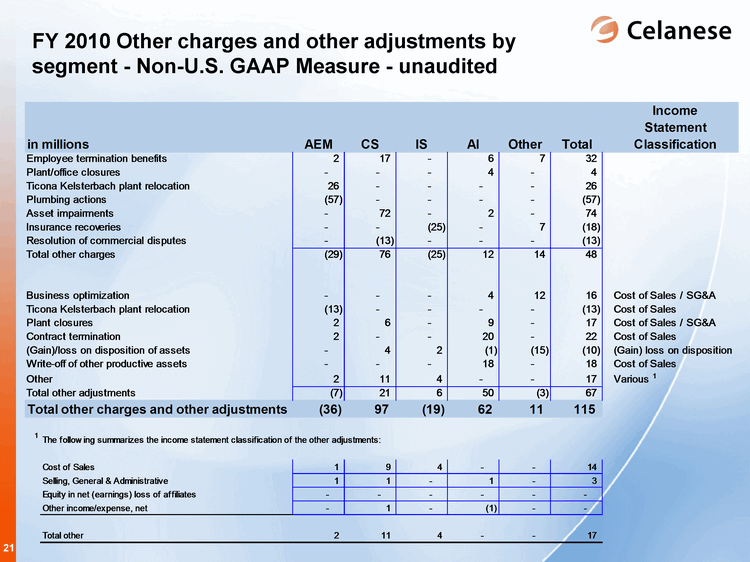
| FY 2010 Other charges and other adjustments by segment - Non-U.S. GAAP Measure - unaudited |
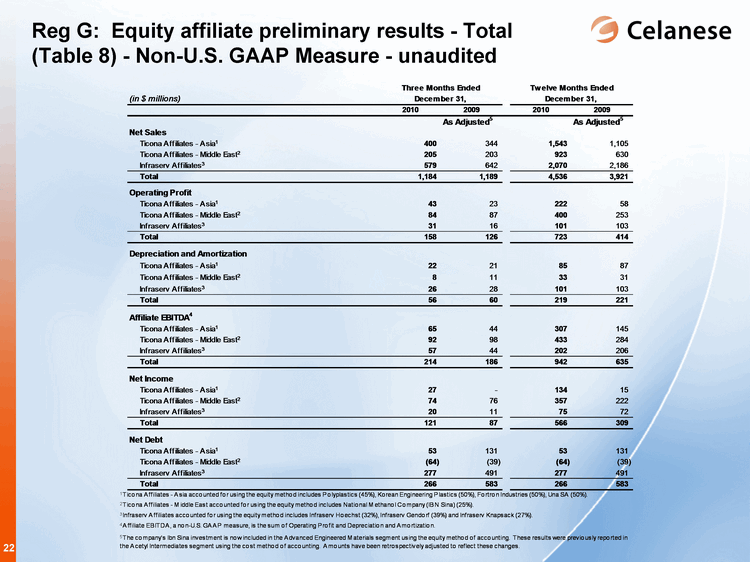
| Reg G: Equity affiliate preliminary results - Total (Table 8) - Non-U.S. GAAP Measure - unaudited |
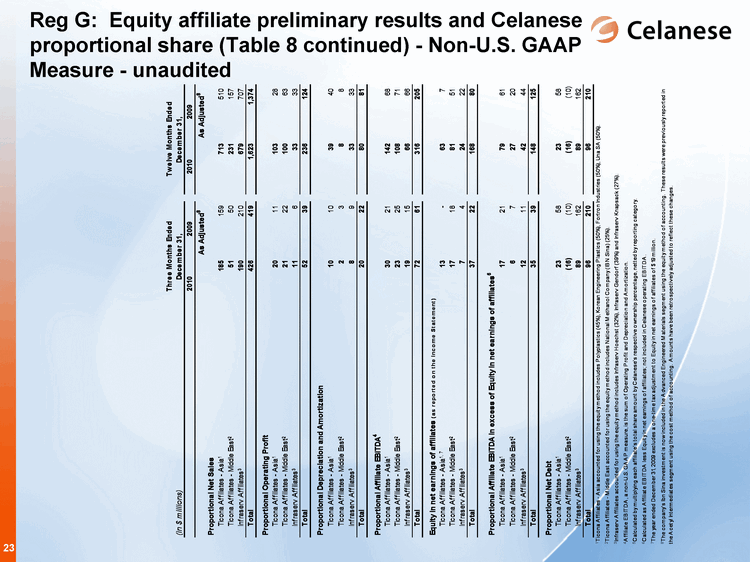
| Reg G: Equity affiliate preliminary results and Celanese proportional share (Table 8 continued) - Non-U.S. GAAP Measure - unaudited |
